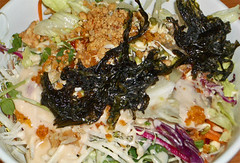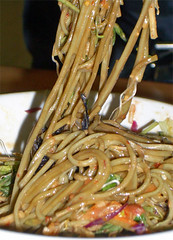Grazing in Green Pasture

Sushi without the rice? Organic vegetables? No meat in sight?
A health-conscious colleague had been raving about this organic vegetarian cafe in Fortune Centre, and insisted that I expand my dining horizon to include healthier alternatives. I like vegetables but am generally wary of places touting healthy-organic style dining as they invariably end up serving bland food with reduced salt, fat/oil and sugar, omitting every other sinful but tasty ingredient. I did not have high hopes for a satisfying lunch when I saw New Green Pasture Cafe, its decor was nondescript, and it had no more than 10 tables (though half were filled with customers). The only spark of hope was when I met Sophia, the owner and chef, who sported a really bright pink beret. Ah-hah...there should be some creativity at work here!
 The first dish arrived - the healthy version of fruit 'rojak'. The normal 'Rojak' is a popular local dish of sliced jicama, cucumber, green mango and pineapple mixed, made unhealthy by the sweet sauce which is a mixture of sugar, chilli sauce and black prawn paste (har-cheong). Sophia's rojak was a mixture of sliced turnip (jicama), pineapple, carrots, green apples, starfruit and really good crunchy beetroot, all held together by a light sweet, spicy and slightly tart sauce, and topped with chopped peanuts. The flavors of molasses and apple cider vinegar in the 'rojak' sauce gave the latter a lovely refreshing taste - not a bad start...
The first dish arrived - the healthy version of fruit 'rojak'. The normal 'Rojak' is a popular local dish of sliced jicama, cucumber, green mango and pineapple mixed, made unhealthy by the sweet sauce which is a mixture of sugar, chilli sauce and black prawn paste (har-cheong). Sophia's rojak was a mixture of sliced turnip (jicama), pineapple, carrots, green apples, starfruit and really good crunchy beetroot, all held together by a light sweet, spicy and slightly tart sauce, and topped with chopped peanuts. The flavors of molasses and apple cider vinegar in the 'rojak' sauce gave the latter a lovely refreshing taste - not a bad start... The sushi roll was next, and as you can see from the top picture, instead of Japanese sticky rice, the roll was essentially julienned/shredded jicama, carrot, beetroot, lettuce, red cabbage etc. wrapped in seaweed. This is easily one of the most delicious 'vege-crunchy' sushi I've ever had, as the julienned vegetables had been mixed in a tasty mayonnaise-like sauce. If I am ever reincarnated as a cow, this has gotta be my main chow.
The sushi roll was next, and as you can see from the top picture, instead of Japanese sticky rice, the roll was essentially julienned/shredded jicama, carrot, beetroot, lettuce, red cabbage etc. wrapped in seaweed. This is easily one of the most delicious 'vege-crunchy' sushi I've ever had, as the julienned vegetables had been mixed in a tasty mayonnaise-like sauce. If I am ever reincarnated as a cow, this has gotta be my main chow. Soba salad came topped with loads of shredded lettuce, red cabbage, seaweed, diced tomatoes, mungbeans and watercress. After thoroughly mixing the entire bowl of soba noodles with the shredded vegetables and sauce which had flavors of sesame oil, mirin(?) and what I was told to be liquid aminase (in place of soya sauce), it was slurp-slurp-slurp until the bowl was clean.
Soba salad came topped with loads of shredded lettuce, red cabbage, seaweed, diced tomatoes, mungbeans and watercress. After thoroughly mixing the entire bowl of soba noodles with the shredded vegetables and sauce which had flavors of sesame oil, mirin(?) and what I was told to be liquid aminase (in place of soya sauce), it was slurp-slurp-slurp until the bowl was clean.Sophia tries to use organic produce as much as possible in her dishes and she also sells organic vegetables, grains and flour and other health-food products at her shop for the converted.
 My colleague called this the 'bak-kut teh' soup without the 'bak-kut' (pork ribs). Mushrooms and compacted chopped mushroom-stems (a Chinese vegetarian product - a slice is shown in picture being picked up by chopsticks) are used as a meaty substitute for the pork ribs, and the soup is brewed with traditional chinese herbs including medlar seeds (kei-chi). Steaming hot, no MSG, with all the goodness of the ingredients developing in the soup.
My colleague called this the 'bak-kut teh' soup without the 'bak-kut' (pork ribs). Mushrooms and compacted chopped mushroom-stems (a Chinese vegetarian product - a slice is shown in picture being picked up by chopsticks) are used as a meaty substitute for the pork ribs, and the soup is brewed with traditional chinese herbs including medlar seeds (kei-chi). Steaming hot, no MSG, with all the goodness of the ingredients developing in the soup. Being greedy, we couldn't resist this vegetarian nasi briyani. Brown rice was cooked with turmeric for the color, and sides included potato/vegetable curry, pumpkin chutney, and more of the delicious fresh organic vegetables cooked and as a salad. I'm a fan of fluffy white Thai jasmine rice, so brown rice is really not my thing though my colleagues were quite happy to give the thumbs up for this dish as well.
Being greedy, we couldn't resist this vegetarian nasi briyani. Brown rice was cooked with turmeric for the color, and sides included potato/vegetable curry, pumpkin chutney, and more of the delicious fresh organic vegetables cooked and as a salad. I'm a fan of fluffy white Thai jasmine rice, so brown rice is really not my thing though my colleagues were quite happy to give the thumbs up for this dish as well. Finally, dessert was bubur-cha-cha with the usual sinful coconut milk being replaced with oat milk and almond powder. Apart from the usual sweet potato cubes, Sophia had added red kidney beans, gingko nuts and lilybulbs (pak-he). A most unusual combination.
Finally, dessert was bubur-cha-cha with the usual sinful coconut milk being replaced with oat milk and almond powder. Apart from the usual sweet potato cubes, Sophia had added red kidney beans, gingko nuts and lilybulbs (pak-he). A most unusual combination.Prices range between $4 to $7 generally per dish, and a good healthy and tasty meal can be had for less than $10 per person (fulfilling the Health Promotion Board's recommended intake of at least 2 cups of vegetables daily).
New Green Pasture Cafe
190 Middle Road #04-22
Fortune Centre
Singapore 188979
Tel: 6336 8755
Open: 11.30 am to 7.30 pm (Closed on Mondays)










